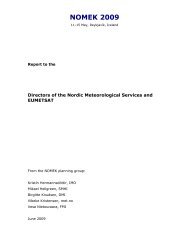International Symposium on Mitigative Measures against Snow ...
International Symposium on Mitigative Measures against Snow ...
International Symposium on Mitigative Measures against Snow ...
Create successful ePaper yourself
Turn your PDF publications into a flip-book with our unique Google optimized e-Paper software.
<str<strong>on</strong>g>Internati<strong>on</strong>al</str<strong>on</strong>g> <str<strong>on</strong>g>Symposium</str<strong>on</strong>g> <strong>on</strong> <strong>Mitigative</strong> <strong>Measures</strong> <strong>against</strong> <strong>Snow</strong> Avalanches<br />
Egilsstaðir, Iceland, March 11–14, 2008<br />
Icelandic avalanches, “Canadian Level 2” course experience is preferable. The avalanche<br />
forecasters meet regularly each week, and this opportunity is partly used for educati<strong>on</strong><br />
purposes. Three or four times during the winter the forecasters receive outdoor training <strong>on</strong><br />
snow structure and avalanche safety. Additi<strong>on</strong>ally, the forecasters occasi<strong>on</strong>ally assist snow<br />
observers with measurements of avalanches, measurements of snow depths, and repairs to<br />
weather stati<strong>on</strong>s.<br />
The snow observers have varying backgrounds. They have either “Canadian Level 1”<br />
experience or a similar level of Icelandic training. Annually, they meet for a two-day seminar,<br />
in additi<strong>on</strong> to working each year with avalanche forecasters or more experience avalanche<br />
workers.<br />
4. WEATHER MEASUREMENTS AND OTHER INFORMATION SOURCES<br />
The most valuable informati<strong>on</strong> for the avalanche forecasting comes from the snow observers<br />
who m<strong>on</strong>itor the local avalanche activity and the stability of the snow-cover. In the northwest<br />
peninsula, avalanches frequently cut across roads, serving as an indicator of further<br />
avalanche activity above towns and villages.<br />
Seven automatic, acoustic snow-depth meters have been placed in starting z<strong>on</strong>es or <strong>on</strong> slopes<br />
that allow direct measurements of snow accumulati<strong>on</strong>. Six more temperature-based, snowdepth<br />
measurement stakes are presently being tested. For many years, the snow observers<br />
have used theodolites from fixed locati<strong>on</strong>s to manually survey snow depth <strong>on</strong> stakes in<br />
avalanche starting z<strong>on</strong>es.<br />
The French model Safran-Crocus-Mepra is run at IMO; this model forecasts theoretical<br />
avalanche danger and it models the metamorphism of snow.<br />
The Meteorological Office operates a few automatic weather stati<strong>on</strong>s <strong>on</strong> mountain tops and<br />
has established several automatic weather stati<strong>on</strong>s in the lowland regi<strong>on</strong>s threatened by<br />
avalanches. The Highway Agency has useful weather stati<strong>on</strong>s as well, with many located <strong>on</strong><br />
mountain roads. These additi<strong>on</strong>al data are available to the avalanche forecasters.<br />
5. WORK PROCEDURES<br />
Code grey<br />
The work of the avalanche forecasters in Reykjavík follows a fixed routine that is well<br />
documented. During the normal winter day (code grey) each avalanche forecaster is <strong>on</strong> shift<br />
for a week. Every morning, the forecaster meets with the duty meteorologist at IMO to<br />
discuss the weather forecast for the following days. The forecast is signed by both people and<br />
it is catalogued. The avalanche forecaster talks to the snow observers at least twice during the<br />
shift period, but more often if weather or snow c<strong>on</strong>diti<strong>on</strong>s are likely to result in avalanches.<br />
The snow observer estimates local avalanche danger using a colour scale, and the estimate is<br />
updated twice a week. The scale of the danger is not communicated to the public at present,<br />
but a change in that policy is under discussi<strong>on</strong>. Data <strong>on</strong> snow profiles and other related<br />
informati<strong>on</strong> are placed <strong>on</strong> a Web-page, which is open to the snow observers, as well as<br />
members of the civil defence and the police.<br />
116 M<strong>on</strong>itoring avalanche danger for Icelandic villages











